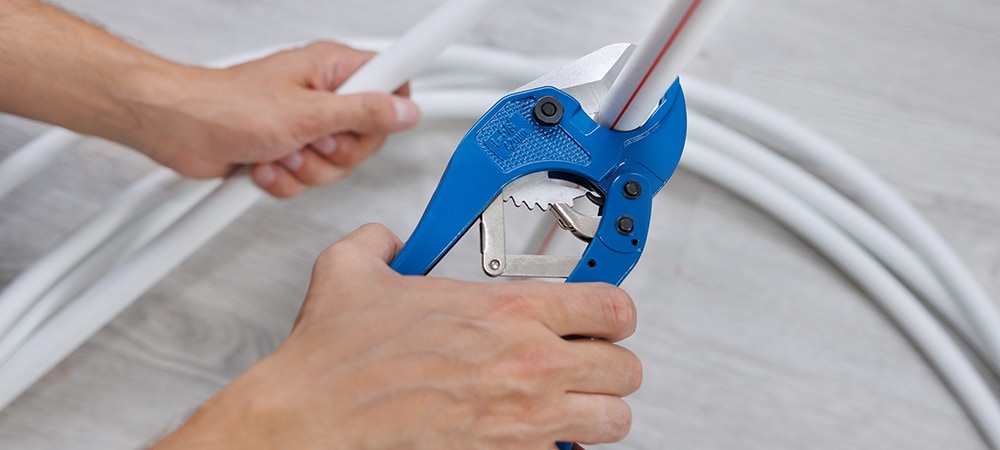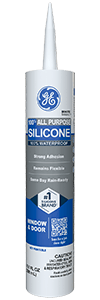Note: This DIY article is provided as a general guide only and is not intended to take the place of product-specific installation procedures; always follow applicable manufacturers’ instructions. Depending on your home’s age and condition, location within the home, and other potential factors, repairs and/or upgrades or other services may be necessary prior to the beginning and/or completion of your project that may involve the services of a home improvement professional. This article does not include advice pertaining to local building codes and/or any related inspections.
Whether it’s rust, buckling, or mold, water damage is an eyesore and a harbinger of serious repair and maintenance costs in the future. Before the floodgates open and wash away your hard-earned money, you should consider learning how to seal a leaking pipe. This article explores some DIY-friendly ways to address leaks and the different types of pipes you may expect to find in your plumbing network.
For large defects on any type of pipe, it would be best to first cut out the damaged section before beginning repairs.
How to seal a leaking pipe: Understanding pipe types
Through the ages, the human race has advanced water delivery systems from primitive clay pipes (in ancient Greece) to cast iron, terra cotta, PVC, copper, galvanized steel, and other materials in modern times. While the principle remains the same, different pipes have been developed to meet your plumbing needs, with some being more efficient than others.
Just as there are many functions of pipes in a plumbing network (from directing sewage to transporting water), a variety of pipes are designed to meet each specific situation. Below are some of the most common pipes you may encounter on your journey to answering the question “How to seal a plastic pipe.”
PVC pipes
Where you’ll find plumbing, you’ll most definitely find PVC pipes. The popularity of PVC pipes stems directly from the benefits they have to offer. A staple in the kitchen and bathroom, polyvinyl chloride pipes (famously abbreviated as PVC) are more plastic than metal in nature and, therefore, have a better weight-to-functionality ratio.
This makes them less expensive to transport, install, and repair. Additionally, PVC remains immune to the problems that plague metallic pipes, such as rust and corrosion that may poison water delivered to your home. The inner lumen of PVC pipes is also incredibly smooth, preventing the accumulation of material that may cause blockages.
Due to their non-biodegradable nature, PVC pipes may outlast your home, making them perfect for long-term use and situations where high pressure is expected, such as with the main line.
Disadvantages of PVC
They might be durable, but PVC pipes are far from indestructible. Some of the drawbacks associated with PVC pipe use include:
- Introduction of microscopic polyvinyl chloride residues into circulation (these have been known to affect cardiovascular, neurological, and respiratory systems)
- Susceptibility to shatter and compressional forces
- Reduced functionality in hot conditions
How to seal PVC pipes to avoid leaks
Proper installation and sealing of PVC pipes help ensure a longer lifespan of the plumbing network. Best practices when sealing PVC pipes include using PVC primer and cement. It would also help to use thread sealant around the male threads (the one with ridges) to ensure a tight fit around the connection. Thread sealant fills any gaps and cracks to avoid leaks.
In high-pressure systems, an additional coating of high-quality silicone sealant across the joints and connections can confer an added layer of protection on the pipe, ensuring leaks do not develop along the lines of weakness.
How to seal a PVC pipe leak
Fixing a leak on a PVC pipe is a relatively straightforward and DIY-friendly process. The complexity of the repair process depends on the size of the leak. You should use a repair kit with a rubber patch and a clamp for small leaks. For larger leaks, you may have to cut out the damaged part and install push-fit connections using a process similar to the abovementioned installation process.
Once the leak is patched up, apply a waterproof silicone sealant around the patchwork or new connections before testing the new seal.
Copper pipes
Copper has been an excellent choice for plumbing solutions for decades, and for good reason. Copper performs well under high-pressure conditions and can adequately deliver water in both extremes of temperatures, excelling in hot and cold conditions. The obvious candidate is a copper pipe when you want to maintain your water quality.
Disadvantages of copper pipes
An expected hurdle with using a precious metal for plumbing is that it is expensive to install, maintain, and replace. Metals are not known for their flexibility, and copper is more rigid than PVC, making it an inferior choice when flexibility is more important.
How to seal copper pipes to avoid leaks
Unlike PVC and plastic pipes, copper pipes are usually installed through a soldering or sweating process. However, when this is unavailable, or you prefer a less permanent fix, you may use compression fittings (including a specialized ring and nut) to create a watertight seal. You should watch out for corrosion in copper pipes, especially when dealing with water of extreme pH.
To combat chemical corrosion, consider installing dielectric unions when connecting copper to other metals with more or less reactivity.
How to seal a copper pipe leak
Copper pipe leaks are more strenuous to seal than plastic and PVC pipes. The leaks tend to occur around joints, pinholes, and seams but may occur in the middle of the pipe (which almost always requires cutting out the damaged part and replacing it with a slip coupling). To fix the leak, you may use clamps, soldering, or compression fittings to restore the pipe’s integrity.
As always, you should finish with a generous coating of waterproof silicone sealant around the joints for extra leak protection.
Plastic pipes
Plastic pipes come in all shapes and sizes. However, the most widely used plastic pipes include:
- PEX (Cross-linked polyethylene)
- CPVC (Chlorinated polyvinylchloride)
- ABS (Acrylonitrile butadiene styrene)
PEX is an affordable plastic pipe that is similar to PVC in many ways with the added advantage of being more flexible. This feature makes it an excellent choice when weaving through walls, crawl spaces, attics, and other tight spaces.
ABS pipes are also similar to PVC pipes but have added resistance to colder temperatures, making them the preferred choice for vents and drain lines. Their black color easily identifies them. CPVC, as the name suggests, is a special type of PVC piping designed for hot and cold pipes.
How to seal a plastic pipe
Sealing a plastic pipe is exactly as described for PVC pipes. However, unlike PVC, plastic pipes require special connectors to remain leak-free during service. For CPVC and ABS, you should apply primer and solvent cement. For PEX, shark-bite fittings (a type of push-to-connect fitting devoid of the need for soldering or glue during installation) are the way to go, as they negate the need for complex tools or expertise.
How to use silicone sealant to seal and fix leaky pipes
Caulk or sealant? This question might cause debate in other projects, but silicone sealant is the only right answer for leaky pipes. Caulk is rigid and inadequate at forming a barrier against moisture, a must-have for plumbing. With that out of the way, here’s how to properly apply silicone sealant to leaky pipes:
- Turn off the water supply
- Clean the area to apply sealant (this may require scraping off oxidation and corrosion for metallic pipes)
- Apply the silicone sealant (for patchwork, squeeze the sealant over the area, ensuring it covers both the affected and unaffected areas. For joints, apply a uniform bead around the entire length of the joint)
- Smoothen the excess sealant with a gloved finger
- Let the sealant cure
- Test the repair
Different types of pipes require different approaches to ensure they remain leak-free, whether during installation or after a leak occurs during its lifetime. Sealing the pipe could mean the difference between extended use and repetitive repairs. With silicone sealant, a little goes a long way. Sealants’ waterproof and weatherproof capabilities make them an excellent barrier to keep water on the right side of the pipe.
To find GE products near you, check out our Where to Buy page.


